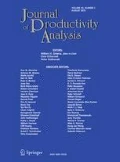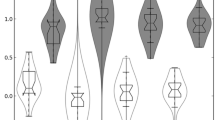Abstract
In productivity research with firm data, the existence of endogenous sample attrition is well known. In addition, endogenous sample selection may occur. In a simple model where heterogenous firms consider entry, exit, worker training and price setting in a monopolistically competitive market, I show that firm heterogeneity leads to self-selecting into the market, which in turn dampens the estimate of the marginal effect of worker training. To address the sample selection issue, I devise a generalized method of simulated moments estimator. Estimations with firm data from China’s shoe manufacturing industry show that an increase of one standard deviation of worker training expenditure intensity results in an around 5.6% decrease in a firm’s labor productivity, larger than the estimate without accounting for endogenous sample selection.
Similar content being viewed by others
Data availability
Data are available upon request from the corresponding author.
Code availability
Codes are available upon request from the corresponding author.
Notes
For example, to name a few, Heckman (1979, 1990), Newey et al. (1990), Nawata and Nagase (1996), Kyriazidou (1997), Heckman et al. (1998), Vella (1998), Francesconi and Nicoletti (2006), Zimmer and Trivedi (2006), Madden (2008), Lee (2009), Newey (2009), Greene (2010), van Hasselt (2011), Vossmeyer (2016), and Semykina and Wooldridge (2018).
In addition, researchers also survey productivity studies from different dimensions, for example Syverson (2011) on why firms have different productivity levels, Ahmed and Bhatti (2020) on measurement and determinants of multi-factor productivity, and Del Gatto et al. (2011) and Van Beveren (2012) on estimating/measuring productivity/total factor productivity.
For example, firms may need to train their workers for a particular skill which is needed in the production process but not available from the labor market.
Note for individual workers who receive training, their skill sets will expand. However, it can occur that the firm’s average labor productivity decreases.
The expectation is taken over both ζ and λ. Besides, note that in taking expectation with respect to ζ, it is possible that x and τ are endogenous, namely E[ζ|x,τ,λ≥\(\underline \lambda\)] = ∫ζdGζ(ζ|x,τ) is a function of x and τ. For τ, I later also use excluded instruments and report the results in the section “Robustness”. For x, assuming ∫ζdGζ(ζ|x,τ) is a linear function of x, it is then absorbed into the term xβ.
Note in Eq. (6), as I focus on the steady state, by conditioning on \(\lambda \ge \underline \lambda\), one also captures endogenous sample attrition. Future research can account for sample attrition (firm dynamics) more elaborately while addressing the sample selection issue.
Note x and z are the same as in Eq. (6).
A similar algorithm has been used by Sun and Anwar (2022) to estimate product quality.
Here lnλ and ζ can be combined into one term. I use the normal distribution, given its prevalence. One can also use other distributions. A frequently used distribution is the Pareto distribution. However, one disadvantage of using the Pareto distribution is that the sample selection effect cancels out the direct effect of x and τ, namely \(E\left[ {{\rm{ln}}s\left| {x,\tau ,\lambda \ge \underline \lambda } \right.} \right]\) does not depend on x and τ, which suggests that the Pareto distribution assumption is likely to be too strong for empirical estimations.
For example, with a sample of 3703 firms in Taiwanese electronics industry in the years 2000 and 2002–2004, Aw et al. (2011) estimate an ρ of 0.8432 in the domestic market.
Alternatively, one can draw the fixed cost from a given distribution.
Note, as discussed in Footnote 5, estimates of the coefficients of x can pick up the effect of x being endogenous. That is, while factors in x directly affect lnS, they can also indirectly affect lns through ζ.
References
Ahmed T, Bhatti AA (2020) Measurement and determinants of multi-factor productivity: A survey of literature. J Econ Surv 34(2):293–319. https://doi.org/10.1111/joes.12360
Amin M, Okou C (2020) Casting a shadow: Productivity of formal firms and informality. Rev Dev Econ 24(4):1610–1630. https://doi.org/10.1111/rode.12697
Anwar S, Sun S (2014) Heterogeneity and curvilinearity of FDI-related productivity spillovers in China’s manufacturing sector. Econ Model 41:23–32. https://doi.org/10.1016/j.econmod.2014.03.021
Aw BY, Roberts MJ, Xu DY (2011) R&D investment, exporting, and productivity dynamics. Am Econ Rev 101(4):1312–1344. https://doi.org/10.1257/aer.101.4.1312
Bárány ZL, Siegel C (2021) Engines of sectoral labor productivity growth. Rev Econ Dyn 39:304–343. https://doi.org/10.1016/j.red.2020.07.007
Battisti M, Belloc F, Del Gatto M (2020) Labor productivity and firm-level TFP with technology-specific production functions. Rev Econ Dyn 35:283–300. https://doi.org/10.1016/j.red.2019.07.003
Baumann J, Kritikos AS (2016) The link between R&D, innovation and productivity: Are micro firms different? Res Policy 45(6):1263–1274. https://doi.org/10.1016/j.respol.2016.03.008
Bjuggren CM (2018) Employment protection and labor productivity. J Public Econ 157:138–157. https://doi.org/10.1016/j.jpubeco.2017.11.007
Bloom DE, Killingsworth MR (1985) Correcting for truncation bias caused by a latent truncation variable. J Econom 27(1):131–135. https://doi.org/10.1016/0304-4076(85)90048-X
Das S, Roberts MJ, Tybout JR (2007) Market entry costs, producer heterogeneity, and export dynamics. Econometrica 75(3):837–873. https://doi.org/10.1111/j.1468-0262.2007.00769.x
De Loecker J (2011) Product differentiation, multiproduct firms, and estimating the impact of trade liberalization on productivity. Econometrica 79(5):1407–1451. https://doi.org/10.3982/ECTA7617
Dearden L, Reed H, Van Reenen J (2006) The impact of training on productivity and wages: Evidence from British Panel Data. Oxf Bull Econ Stat 68(4):397–421. https://doi.org/10.1111/j.1468-0084.2006.00170.x
Del Gatto M, Di Liberto A, Petraglia C (2011) Measuring productivity. J Econ Surv 25(5):952–1008. https://doi.org/10.1111/j.1467-6419.2009.00620.x
Dua P, Garg NK (2019) Determinants of labour productivity: Comparison between developing and developed countries of Asia-Pacific. Pac Econ Rev 24(5):686–704. https://doi.org/10.1111/1468-0106.12294
Francesconi M, Nicoletti C (2006) Intergenerational mobility and sample selection in short panels. J Appl Econom 21(8):1265–1293. https://doi.org/10.1002/jae.910
Gandhi A, Navarro S, Rivers DA (2020) On the identification of gross output production functions. J Political Econ 128(8):2973–3016. https://doi.org/10.1086/707736
Greene W (2010) A stochastic frontier model with correction for sample selection. J Product Anal 34(1):15–24. https://doi.org/10.1007/s11123-009-0159-1
Gregory-Smith I (2021) Wages and labor productivity: Evidence from injuries in the National Football League. Econ Inq 59(2):829–847. https://doi.org/10.1111/ecin.12960
He J, Liu H, Salvo A (2019) Severe air pollution and labor productivity: Evidence from industrial towns in China. Am Econ J 11(1):173–201. https://doi.org/10.1257/app.20170286
Heckman J (1979) Sample selection bias as a specification error. Econometrica 47(1):153–161. https://doi.org/10.2307/1912352
Heckman J (1990) Selection bias and self-selection. In: Eatwell J, Milgate M, Newman P (eds) The new palgrave: A dictionary of economics. Palgrave Macmillan, London
Heckman J, Ichimura H, Smith J, Todd P (1998) Characterizing selection bias using experimental data. Econometrica 66(5):1017–1098. https://doi.org/10.2307/2999630
Helpman E, Melitz MJ, Yeaple SR (2004) Export versus FDI with heterogeneous firms. Am Econ Rev 94(1):300–316. https://doi.org/10.1257/000282804322970814
Hoffman M, Burks SV (2020) Worker overconfidence: Field evidence and implications for employee turnover and firm profits. Quant Econ 11(1):315–348. https://doi.org/10.3982/QE834
Holzer HJ (1990) The determinants of employee productivity and earnings. Ind Relat 29(3):403–422. https://doi.org/10.1111/j.1468-232X.1990.tb00761.x
Idson TL, Oi WY (1999) Workers are more productive in large firms. Am Econ Rev 89(2):104–108. http://www.jstor.org/stable/117089
Ku H (2020). Does minimum wage increase labor productivity? Evidence from piece rate workers. IZA Discussion Paper (13369). https://ssrn.com/abstract=3628244
Kyriazidou E (1997) Estimation of a panel data sample selection model. Econometrica 65(6):1335–1364. https://doi.org/10.2307/2171739
Lee DS (2009) Training, wages, and sample selection: Estimating sharp bounds on treatment effects. Rev Econ Stud 76(3):1071–1102. https://doi.org/10.1111/j.1467-937X.2009.00536.x
LoPalo MC (2019) Essays on the determinants of worker productivity and labor market outcomes. PhD thesis. University of Texas at Austin, Austin
Madden D (2008) Sample selection versus two-part models revisited: The case of female smoking and drinking. J Health Econ 27(2):300–307. https://doi.org/10.1016/j.jhealeco.2007.07.001
Nawata K, Nagase N (1996) Estimation of sample selection bias models. Econom Rev 15(4):387–400. https://doi.org/10.1080/07474939608800363
Nevo A (2003) Using weights to adjust for sample selection when auxiliary information is available. J Bus Econ Stat 21(1):43–52. https://doi.org/10.1198/073500102288618748
Newey WK (2009) Two‐step series estimation of sample selection models. Econom J 12(suppl_1):S217–S229. https://doi.org/10.1111/j.1368-423X.2008.00263.x
Newey WK, Powell JL, Walker JR (1990) Semiparametric estimation of selection models: Some empirical results. Am Econ Rev 80(2):324–328. http://www.jstor.org/stable/2006593
Ng YC (2005) Training determinants and productivity impact of training in China: a case of Shanghai. Econ Educ Rev 24(3):275–295. https://doi.org/10.1016/j.econedurev.2004.05.005
Olley GS, Pakes A (1996) The dynamics of productivity in the telecommunications equipment industry. Econometrica 64(6):1263–1297. https://doi.org/10.2307/2171831
Pariboni R, Tridico P (2020) Structural change, institutions and the dynamics of labor productivity in Europe. J Evol Econ 30(5):1275–1300. https://doi.org/10.1007/s00191-019-00641-y
Raymond W, Mairesse J, Mohnen P, Palm F (2015) Dynamic models of R&D, innovation and productivity: Panel data evidence for Dutch and French manufacturing. Eur Econ Rev 78:285–306. https://doi.org/10.1016/j.euroecorev.2015.06.002
Sala H, Silva JI (2013) Labor productivity and vocational training: evidence from Europe. J Product Anal 40(1):31–41. https://doi.org/10.1007/s11123-012-0304-0
Samargandi N (2018) Determinants of labor productivity in MENA countries. Emerg Mark Finance Trade 54(5):1063–1081. https://doi.org/10.1080/1540496X.2017.1418658
Semykina A, Wooldridge JM (2018) Binary response panel data models with sample selection and self-selection. J Appl Econom 33(2):179–197. https://doi.org/10.1002/jae.2592
Sun S (2011) Foreign direct investment and technology spillovers in China’s manufacturing sector. Chinese Econ 44(2):25–42. https://doi.org/10.2753/1097-1475440202
Sun S, Anwar S (2022) Estimation of product quality in China’s food processing and manufacturing industries. Econ Model 107:105681. https://doi.org/10.1016/j.econmod.2021.105681
Syverson C (2011) What determines productivity? J Econ Lit 49(2):326–365. https://doi.org/10.1257/jel.49.2.326
Tombe T, Zhu X (2019) Trade, migration, and productivity: A quantitative analysis of China. Am Econ Rev 109(5):1843–1872. https://doi.org/10.1257/aer.20150811
Van Beveren I (2012) Total factor productivity estimation: A practical review. J Econ Surv 26(1):98–128. https://doi.org/10.1111/j.1467-6419.2010.00631.x
van Hasselt M (2011) Bayesian inference in a sample selection model. J Econom 165(2):221–232. https://doi.org/10.1016/j.jeconom.2011.08.003
Vella F (1998) Estimating models with sample selection bias: A survey. J Human Resour 33(1):127–169. https://doi.org/10.2307/146317
Vossmeyer A (2016) Sample selection and treatment effect estimation of lender of last resort policies. J Bus Econ Stat 34(2):197–212. https://doi.org/10.1080/07350015.2015.1024837
Xu X, Sheng Y (2012) Productivity spillovers from foreign direct investment: Firm-level evidence from China. World Dev 40(1):62–74. https://doi.org/10.1016/j.worlddev.2011.05.006
Yao Y (2019) Does higher education expansion enhance productivity? J Macroecon 59:169–194. https://doi.org/10.1016/j.jmacro.2018.11.009
Zhang J, Mishra AK, Zhu P, Li X (2020) Land rental market and agricultural labor productivity in rural China: A mediation analysis. World Dev 135:105089. https://doi.org/10.1016/j.worlddev.2020.105089
Zheng L, Batuo ME, Shepherd D (2017) The impact of regional and institutional factors on labor productive performance—Evidence from the township and village enterprise sector in China. World Dev 96:591–598. https://doi.org/10.1016/j.worlddev.2017.04.006
Zimmer DM, Trivedi PK (2006) Using trivariate copulas to model sample selection and treatment effects. J Bus Econ Stat 24(1):63–76. https://doi.org/10.1198/073500105000000153
Author information
Authors and Affiliations
Corresponding author
Ethics declarations
Conflict of interest
The author declares no competing interests.
Additional information
Publisher’s note Springer Nature remains neutral with regard to jurisdictional claims in published maps and institutional affiliations.
Rights and permissions
Springer Nature or its licensor (e.g. a society or other partner) holds exclusive rights to this article under a publishing agreement with the author(s) or other rightsholder(s); author self-archiving of the accepted manuscript version of this article is solely governed by the terms of such publishing agreement and applicable law.
About this article
Cite this article
Sun, S. Firm heterogeneity, worker training and labor productivity: the role of endogenous self-selection. J Prod Anal 59, 121–133 (2023). https://doi.org/10.1007/s11123-022-00652-1
Accepted:
Published:
Issue Date:
DOI: https://doi.org/10.1007/s11123-022-00652-1
Keywords
- Firm heterogeneity
- Worker training
- Labor productivity
- Sample selection
- Method of simulated moments
- Cross-sectional analysis




